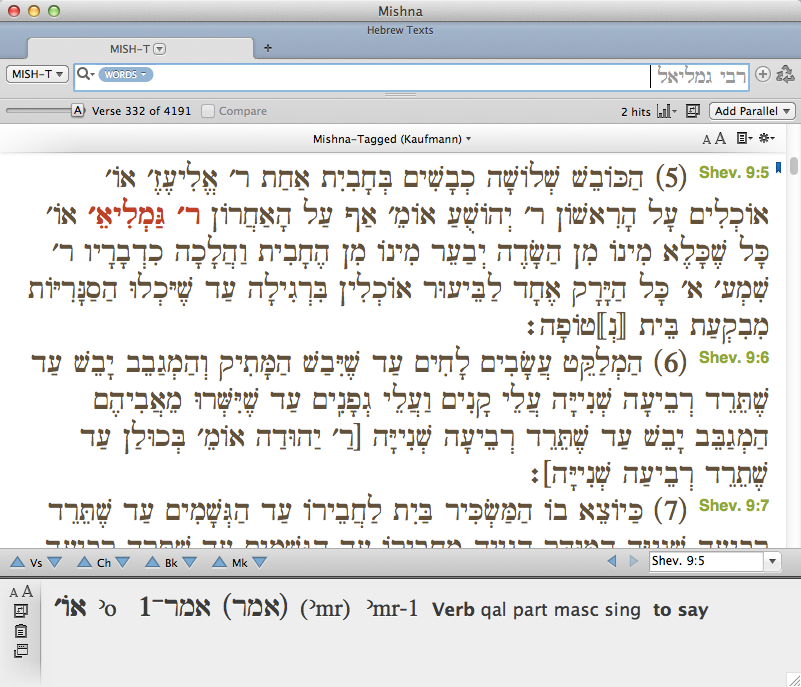Accordance’s Tagged Mishnah Provides an Unparalleled Resource for Illuminating First Century Judaism
![]() Introducing the Mishnah
Introducing the Mishnah
The Second Temple period witnessed an eruption of scribal activity in the Jewish World evidenced both in the literary treasures it produced then, and the scholarly attention the period receives now by countless enthusiasts of early Judaism. But along with this literary activity of the Second Temple period was an equally important oral movement comprised of debates among the earliest rabbinic leaders of the day regarding the finer points of biblical law. The Schools of Shammai and Hillel, dating to the first century BCE, are perhaps two of the more famous adversaries named in the debates. These oral deliberations were initially kept alive through memory and repetition. But eventually, they were penned into 63 tractates, and by about 200 CE, were gathered together into an impressive collection of six sedarim (orders) known to us today as the Mishnah. This earliest gathering of rabbinic traditions subsequently serves as the framework for the later analysis and commentaries of the Tosefta (400 CE), the Babylonian Talmud (400 CE) and the Palestinian Talmud (500 CE). Thus, the Mishnah survives not only as rabbinic literature’s most antique collection, but as its most formative one as well.
![]() The Importance of the Mishnah
The Importance of the Mishnah
Though the Mishnah includes later rulings which date up to its 3rd century CE redaction, much of the work’s primary value for modern scholarship is its preservation of early traditions, particularly those of the aforementioned Schools, as well as the sayings and rulings of the first generation Tannaim (rabbinic teachers from 10-80 CE). These earliest layers of Mishnaic strata reveal the nature of religious discussion among the founding rabbis, thus illuminating important traditions of first century CE Judaism. This is important for comparative studies with other first century Judaisms such as the Pharisaic, Sadducean, Essene and Christian varieties. It is due to the immeasurable value of the Mishnah for both Judaic and Christian studies that OakTree Software has developed the module MISH-T as an unparalleled electronic access to the Hebrew text of rabbinic literature’s founding corpus.
![]() Development of MISH-T
Development of MISH-T
For this module, OakTree selected the most important surviving manuscript of the Mishnah, Kaufman A 50, and spent two years transcribing and grammatically tagging facsimiles of every folio (the Kaufmann Mishna Codex Facsimile is available from Accordance). The result is a completely lemmatized and searchable module of all 63 tractates, allowing the user to perform all varieties of searches by lemma, inflection, or phrase, with all parsing information provided in the search result.
![]() Mish-T Mapping with other Accordance Modules
Mish-T Mapping with other Accordance Modules
Conveniently, MISH-T has been mapped with MISH-N, Jacob Neusner’s English translation, thus accommodating the needs of a variety of Hebrew proficiencies among its users. Additionally, the module has been mapped to MISHNA, the standard Hebrew text of the Mishnah (the basis for Neusner’s translation), thus allowing the user to identify important variants attested in the Kaufmann manuscript. Though MISH-T is mapped according to standard mishnafication, the Kaufmann manuscript at places preserves variant borders for its mishnayot (verses). The Kaufmann mishnafication has been preserved in MISH-T by use of parenthesis. This can be observed in the sample screen below, where the second half (indicated by the letter bet) of Kaufmann Avot 1:4 continues beyond the standard mishnah ending, with Kaufmann Avot 1:5 actually beginning in the middle of standard Avot 1:5. This sample also illustrates the benefit of placing MISH-T in parallel with the MISH-N and MISHNA modules.
![]() Conclusion
Conclusion
MISH-T is invaluable for a great variety of research interests, and opens the door to a field of study that contains immeasurable opportunities. It has only been in recent decades that English scholarship has begun to take seriously the implications of rabbinic study. Important resources such as MISH-T will provide this emerging generation of scholars the tools needed in order to determine the precise nature in which the Mishnah shapes the landscape of first century Judaism.
Article Author: Casey Toews
(Article images updated September 2013)



